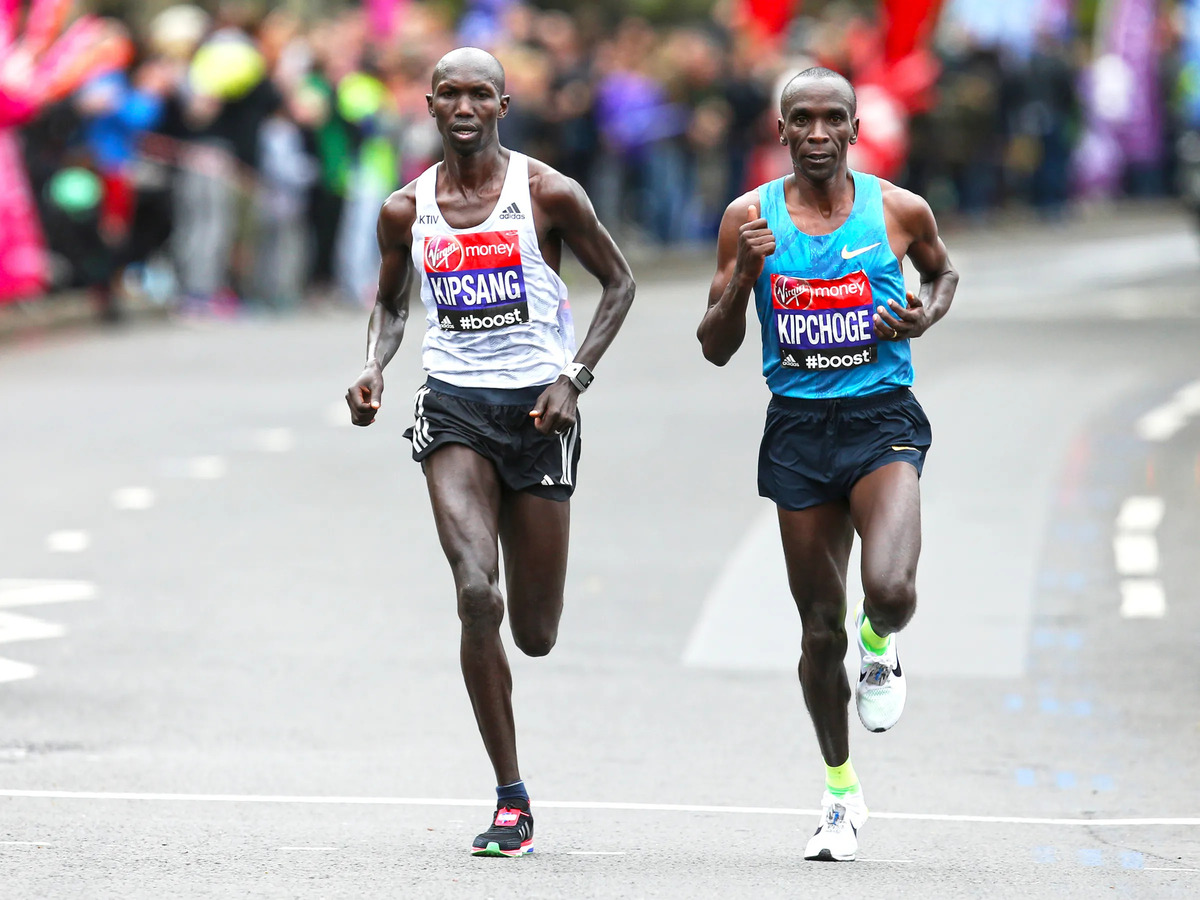

Featured
How To Train For A Marathon In 6 Months
Modified: March 1, 2024
Get the featured tips and tricks on how to train for a marathon in just 6 months. Start your journey to becoming a marathon runner today!
Introduction
Welcome to the world of marathon training! Whether you are a seasoned runner looking to conquer a new distance or a beginner embarking on your first marathon journey, this comprehensive guide will provide you with the necessary steps to train effectively and achieve your goals. Training for a marathon is a challenging but incredibly rewarding endeavor that requires dedication, perseverance, and proper planning.
Running a marathon is much more than just putting one foot in front of the other. It requires careful preparation, both mentally and physically, to ensure that you make it to the starting line feeling confident and ready to tackle the distance.
In this article, we will walk you through the key steps involved in training for a marathon over a six-month period. From setting realistic goals to developing a training plan, choosing the right gear, maintaining proper nutrition, and preventing injuries, we will cover it all. By following these steps, you will be well on your way to crossing that finish line with pride.
Training for a marathon is an individual journey, and what works for one person may not work for another. It’s important to listen to your body, make adjustments when needed, and seek guidance from experienced runners or coaches. Remember, the following steps are general guidelines to help you get started, but feel free to tailor them to suit your own needs and abilities.
Now, let’s dive into the first step of marathon training: setting goals.
Step 1: Setting goals
Before you lace up your running shoes and hit the pavement, it’s essential to establish clear and measurable goals for your marathon training journey. Setting goals will not only give you a target to strive for but also help you stay motivated and focused throughout the process.
When setting your marathon goals, it’s important to consider both the outcome goals and the process goals. The outcome goals are the ultimate achievements you want to reach, such as completing the marathon in a specific time or finishing within a certain rank. Process goals, on the other hand, focus on the actions and behaviors you need to maintain to achieve your desired outcome.
Start by setting a realistic and challenging outcome goal for your marathon. Consider your current fitness level, previous running experience, and the time you have available to train. Make sure your goal is specific, measurable, attainable, relevant, and time-bound (SMART). For example, your outcome goal could be to finish the marathon in under four hours.
Once you have your outcome goal established, break it down into smaller process goals. These goals will help guide your training and ensure that you are consistently working towards your desired outcome. Process goals may include running a certain number of miles per week, incorporating speed workouts, or completing long runs on specific days.
It’s important to regularly evaluate your progress and adjust your goals as needed. As you build strength and endurance throughout your training, you may find that you are capable of achieving more than you initially thought. On the other hand, if you encounter setbacks or obstacles, be flexible and adjust your goals accordingly.
Your goals should also align with your personal motivations for running a marathon. Whether it’s for personal achievement, charity fundraising, or simply the love of the sport, understanding your reasons for embarking on this journey will fuel your determination during challenging times.
Remember, setting realistic and attainable goals will allow you to stay motivated and enjoy the process of training for a marathon. While it’s important to push yourself and aim high, ensure that your goals are within reach to avoid unnecessary stress or disappointment.
Now that you have set your goals, let’s move on to the next step: building a solid base for your marathon training.
Step 2: Building a base
Building a strong base is a crucial foundation for successful marathon training. A solid base refers to establishing a level of fitness and endurance that will allow you to handle the higher mileage and intense workouts that come later in your training plan.
When starting your marathon training journey, it’s essential not to rush into high-intensity workouts right away. Instead, focus on gradually increasing your mileage and building your aerobic endurance. This phase typically lasts for a few weeks or even a couple of months, depending on your fitness level.
During this base-building phase, aim for consistency rather than pushing for speed or distance records. The key is to train regularly and gradually increase your mileage each week. Start with comfortable, easy-paced runs and gradually add more minutes to your runs as you feel comfortable.
It’s also a good time to focus on improving your running form and technique. Pay attention to your posture, stride length, and foot strike to ensure efficiency and reduce the risk of injury. Consider working with a running coach or watching instructional videos to learn proper running mechanics.
In addition to running, cross-training activities such as cycling, swimming, or strength training can complement your base-building phase. These exercises help build overall strength, prevent muscle imbalances, and reduce the risk of overuse injuries.
Don’t forget the importance of rest and recovery during this phase as well. Listen to your body and take rest days as needed to allow for proper healing and avoid burnout. Incorporate stretching and foam rolling into your routine to improve flexibility and reduce muscle soreness.
Remember, the goal of building a base is to prepare your body for more challenging training in the upcoming weeks. By gradually increasing your mileage, focusing on proper form, and incorporating cross-training, you will set the stage for a successful marathon training program.
Now that you have built a solid base, it’s time to move on to the next step: designing a personalized training plan tailored to your goals and abilities.
Step 3: Designing a training plan
Now that you have built a strong base, it’s time to design a personalized training plan that will guide you towards your marathon goals. A well-designed training plan will provide structure, variety, and progression to ensure proper development and minimize the risk of injury.
When designing your training plan, consider the following key components:
- Weekly Mileage: Determine the number of miles you will run each week, taking into account your current fitness level and the goals you’ve set. Gradually increase the mileage over time to avoid overtraining and allow your body to adapt.
- Long Runs: Schedule a weekly long run to build endurance and mental toughness. Start with a distance that is comfortable for you and gradually increase it by 1-2 miles each week. Aim to complete your longest run a few weeks before the marathon to allow for proper tapering.
- Speed Workouts: Incorporate interval training, tempo runs, and hill repeats into your training plan to improve speed and build cardiovascular fitness. These workouts can include timed intervals, such as running at a faster pace for a specific distance or duration, followed by a recovery period.
- Rest and Recovery: Include rest days and easier runs in your plan to allow your body to recover and prevent overtraining. Rest days are just as important as training days and will help you avoid burnout and injuries.
- Cross-training: Consider including cross-training activities, such as swimming, cycling, or strength training, on your non-running days. These activities can help improve overall fitness, strengthen muscles, and prevent overuse injuries.
It’s also beneficial to break your training plan into smaller phases or cycles. Start with a base-building phase, then gradually introduce more intense workouts and longer runs. Incorporate cutback weeks, where mileage is reduced to aid in recovery and prevent overtraining. The final phase should focus on tapering, reducing the mileage to allow your body to rest and be ready for race day.
Remember that every runner is unique, and what works for others may not work for you. Adjust your training plan based on your own abilities, constraints, and preferences. Be flexible and listen to your body. If you feel excessively fatigued or experience pain, don’t hesitate to modify or skip a workout.
Lastly, keep a training log to track your progress, how you feel during each run, and any notes or observations. This record will help you identify patterns, evaluate what works for you, and make adjustments to your training plan as needed.
Now that you have designed a personalized training plan, let’s move on to step four: choosing the right gear for marathon training.
Step 4: Choosing the right gear
When it comes to marathon training, having the right gear is essential for comfort, performance, and injury prevention. From running shoes to clothing and accessories, investing in quality gear that suits your needs and preferences can make a significant difference in your training experience.
The most important piece of gear for any runner is a good pair of running shoes. Visit a specialty running store or consult with a professional to determine the right type of shoe for your foot shape, gait, and running style. Consider factors such as cushioning, stability, and flexibility to find a shoe that provides the necessary support and comfort for long-distance running.
In addition to shoes, proper clothing is crucial for running in various weather conditions. Opt for moisture-wicking, breathable fabrics that help regulate body temperature and prevent chafing. Dress in layers for cooler temperatures, and don’t forget to protect yourself from the sun with a hat, sunglasses, and sunscreen.
Other gear considerations may include:
- Running socks: Choose socks made of moisture-wicking materials to keep your feet dry and reduce the risk of blisters.
- GPS watch or smartphone app: Use a device to track your distance, pace, and heart rate during your runs. This data can help you monitor your progress and adjust your training as needed.
- Hydration system: Invest in a handheld water bottle, hydration belt, or a hydration pack to ensure you stay hydrated during long runs.
- Running accessories: Consider items such as a foam roller for self-massage, a running belt for storing essentials, or compression socks to improve circulation and aid in recovery.
Remember that comfort is key when selecting your gear. Don’t wait until race day to test new shoes or clothing. Wear them during your training runs to ensure they fit properly and don’t cause discomfort or rubbing.
Lastly, don’t underestimate the importance of maintaining your gear. Replace your running shoes regularly to prevent worn-out cushioning and reduce the risk of injury. Keep your gear clean and dry to prolong its lifespan. Taking care of your gear will ensure its functionality throughout your marathon training journey.
Now that you have chosen the right gear, let’s move on to step five: Nutrition and hydration.
Step 5: Nutrition and hydration
Proper nutrition and hydration play a crucial role in fueling your body and optimizing performance during marathon training. A well-balanced diet and effective hydration strategies can help you maintain energy levels, support muscle recovery, and prevent cramping or dehydration.
Here are some key considerations for nutrition and hydration during your marathon training:
- Balanced diet: Focus on consuming a variety of nutrient-dense foods, including lean proteins, whole grains, fruits, vegetables, and healthy fats. These foods provide essential vitamins, minerals, and antioxidants that support overall health and performance.
- Carbohydrate intake: Carbohydrates are the primary source of energy for endurance activities. Ensure that your diet includes ample amounts of carbohydrates, such as whole grains, starchy vegetables, and fruits, to fuel your runs and aid in recovery.
- Protein intake: Protein is crucial for muscle repair and recovery. Include lean sources of protein, such as poultry, fish, legumes, and dairy, in your meals and snacks to support muscle growth and repair.
- Hydration: Stay hydrated throughout the day by drinking water regularly. During long runs, consider carrying a hydration system or plan routes with water fountains or aid stations. Electrolyte-containing drinks can also help replenish electrolytes lost through sweating.
- Pre-run fuel: Consume a meal or snack rich in carbohydrates and moderate in protein before your runs to provide energy and prevent hunger. Experiment with different pre-run meals to find what works best for your digestion and energy levels.
- During-run fuel: During longer runs, consume easily digestible carbohydrates, such as energy gels, chews, or sports drinks, to maintain energy levels. Practice fueling during your training runs to identify what works best for you without causing digestive issues.
- Post-run recovery: Refuel and aid in muscle recovery by consuming a meal or snack with a combination of carbohydrates and protein within 30 minutes to 1 hour after your run. This helps replenish glycogen stores and promote muscle repair.
Every runner’s nutritional needs may vary, so it’s essential to pay attention to your body and experiment with different food and hydration strategies during training. Consider consulting a registered dietitian who specializes in sports nutrition to develop a customized nutrition plan that aligns with your specific goals and needs.
Now that you have a solid understanding of nutrition and hydration, let’s move on to step six: cross-training and strength exercises.
Step 6: Cross-training and strength exercises
While running forms the foundation of marathon training, incorporating cross-training and strength exercises into your routine can greatly enhance your performance and reduce the risk of injury. These activities help develop overall fitness, improve muscle strength, and address any muscular imbalances that running alone may not target.
Cross-training refers to engaging in activities other than running that are still cardiovascular in nature. Some popular cross-training options include cycling, swimming, rowing, elliptical training, or even brisk walking. These activities provide a break from the repetitive impact of running while still boosting cardiovascular fitness.
In addition to cross-training, incorporating regular strength training exercises into your routine is crucial for runners. Strong muscles and a stable core help support better running form and reduce the risk of overuse injuries. Focus on exercises that target the major muscle groups such as leg exercises (e.g., squats, lunges), core exercises (e.g., planks, Russian twists), and upper body exercises (e.g., push-ups, shoulder presses).
Strength training can be done using bodyweight exercises, resistance bands, free weights, or machines. Aim for at least two to three strength training sessions per week, focusing on proper form and gradually increasing the intensity and weights as you progress.
Don’t forget to include flexibility and mobility exercises as well. Stretching, yoga, or exercises using foam rollers or massage balls can help improve flexibility, reduce muscle tension, and enhance recovery.
Remember, cross-training and strength exercises should complement your running, not replace it. Strike a balance between these activities and your running schedule to avoid overtaxing your body. Listen to your body, and if you feel excessively fatigued or experience any pain, modify your routine or consult with a professional.
Now that you understand the importance of cross-training and strength exercises, let’s move on to step seven: running techniques and form.
Step 7: Running techniques and form
Running techniques and form play a significant role in your efficiency, speed, and injury prevention during marathon training. Improving your running mechanics can help you conserve energy, reduce strain on your muscles and joints, and perform at your best.
Here are some tips to improve your running techniques and form:
- Posture: Maintain an upright posture with your head facing forward, shoulders relaxed, and arms at a 90-degree angle. Avoid slouching or leaning too far forward or backward.
- Foot strike: Aim for a midfoot or forefoot strike, where your foot lands beneath your hips instead of the heel striking the ground first. This promotes better shock absorption and reduces the risk of injuries such as shin splints or plantar fasciitis.
- Cadence: Strive for a quick turnover rate, or cadence, of around 160-180 steps per minute. This can help you maintain a smoother and more efficient running stride.
- Stride length: Avoid overstriding, which means landing with your foot too far in front of your body. Instead, focus on maintaining a comfortable stride length that allows for a natural and balanced running motion.
- Arm swing: Keep a relaxed arm swing, with your elbows bent at about a 90-degree angle. The movement should be back and forth, not across your body. Engaging your arms can help propel you forward and maintain balance.
- Cadence: Strive for a quick turnover rate, or cadence, of around 160-180 steps per minute. This can help you maintain a smoother and more efficient running stride.
- Breathing: Practice relaxed and controlled breathing to optimize oxygen intake. Take deep breaths from your diaphragm, exhaling fully, and avoid shallow and rapid breathing patterns.
Improving your running techniques and form takes time and practice. Consider working with a running coach or joining a running group to receive expert guidance and feedback. They can provide insights tailored to your specific needs and help you make the necessary adjustments.
Be patient with yourself as you work on improving your running techniques. Focus on making gradual improvements and listen to your body to avoid pushing too hard or overcorrecting, which could lead to other issues.
Now that you have a better understanding of running techniques and form, let’s move on to step eight: injury prevention and recovery.
Step 8: Injury prevention and recovery
Injury prevention and recovery are vital aspects of marathon training. The repetitive nature and high impact of long-distance running can put stress on your body, making it crucial to prioritize proper recovery and injury prevention strategies.
Here are some key steps to help you prevent injuries and recover effectively:
- Listen to your body: Pay attention to any signs of pain, discomfort, or fatigue. Pushing through pain can lead to more serious injuries. Rest, ice, compression, and elevation (RICE) can be useful for minor aches and pains.
- Gradual training progression: Avoid sudden increases in mileage or intensity, as this can overwhelm your body and increase the risk of injuries. Stick to the 10% rule—never increase your weekly mileage by more than 10% compared to the previous week.
- Cross-train and strengthen: Incorporate cross-training activities and strength exercises to improve muscular balance, stability, and overall fitness. Strengthening supporting muscles can help prevent common running injuries.
- Proper warm-up and cool-down: Warm up before each run with dynamic stretches and exercises to increase blood flow and loosen up your muscles. Cooling down with static stretches and foam rolling can aid in recovery and prevent muscle tightness.
- Rest and recovery: Allow for adequate rest days in your training plan to give your body time to repair and adapt. Sleep is also crucial for recovery, so aim for sufficient and quality sleep each night.
- Massage and self-care: Consider regular sports massages or using self-massage tools like foam rollers or massage balls to relieve muscle tension and improve circulation.
- Proper nutrition: Fuel your body with a well-balanced diet that provides the necessary nutrients for recovery and tissue repair. Adequate protein, carbohydrates, and healthy fats are essential.
- Listen to professionals: Seek guidance from healthcare professionals, such as physical therapists or sports medicine specialists, if you experience persistent pain or suspect an injury. They can provide valuable advice and rehabilitation strategies.
Remember, prevention is key when it comes to injuries, so take proactive measures to protect your body throughout your marathon training journey. By implementing these strategies, you can minimize the risk of injuries and keep yourself on track towards achieving your goals.
Now that you understand the importance of injury prevention and recovery, let’s move on to step nine: mental preparation and motivation.
Step 9: Mental preparation and motivation
Training for a marathon is not just a physical challenge; it also requires mental strength and resilience. Mental preparation plays a crucial role in keeping you motivated, focused, and able to push through the inevitable ups and downs of training. Here are some strategies to help you stay mentally prepared and motivated:
- Set clear intentions: Clearly define your reasons for running a marathon and the goals you want to achieve. Having a clear purpose will help you stay committed and focused throughout your training.
- Visualize success: Use visualization techniques to imagine yourself crossing the finish line, feeling strong and accomplished. Visualizing success can boost your confidence and motivation, especially during challenging training runs.
- Positive self-talk: Replace negative thoughts or self-doubt with positive affirmations and encouraging self-talk. Remind yourself of your progress, strength, and capability to overcome obstacles.
- Break it down: Break your training program into smaller milestones and celebrate each achievement along the way. Focusing on smaller milestones can make the overall journey feel more manageable and rewarding.
- Find a support system: Surround yourself with a supportive network of family, friends, or fellow runners who understand and encourage your marathon goals. Having a support system can provide motivation, accountability, and camaraderie during challenging times.
- Reward yourself: Treat yourself to rewards or incentives for reaching certain milestones or completing tough workouts. This can help reinforce positive behavior and give you something to look forward to.
- Embrace the journey: Remember that marathon training is not just about the end goal; it’s about the process and the personal growth you experience along the way. Embrace the ups and downs, and cherish the progress you make during training.
- Stay inspired: Read books, watch documentaries, or listen to podcasts about marathoners and their journey. Engaging with inspiring stories and role models can fuel your motivation and provide a fresh perspective.
It’s important to note that motivation may naturally ebb and flow during marathon training. During times of low motivation, remind yourself of why you started and the progress you have made so far. Surround yourself with positivity, and focus on the joy and fulfillment that running brings to your life.
Now that you have learned the importance of mental preparation and motivation, it’s time to put all these steps together and embark on your marathon training journey with confidence and determination.
Conclusion
Congratulations! You now have a comprehensive understanding of the key steps involved in training for a marathon. From setting goals to building a solid base, designing a training plan, choosing the right gear, focusing on nutrition and hydration, incorporating cross-training and strength exercises, refining your running techniques, prioritizing injury prevention and recovery, and staying mentally prepared, you are equipped with the knowledge and strategies to embark on your marathon training journey.
Remember, marathon training requires dedication, discipline, and perseverance. It won’t always be easy, but the sense of accomplishment and pride that comes with crossing that finish line will make it all worthwhile. Embrace the challenges, listen to your body, and adapt as needed. Seek support from fellow runners or experienced coaches, and don’t forget to celebrate your progress along the way.
As you embark on this marathon training journey, keep in mind that everyone’s experience is unique. What works for one person may not work for another. Tailor these steps to fit your own needs, abilities, and circumstances.
Stay motivated, stay disciplined, and most importantly, enjoy the process. The marathon is not just a race, but a transformative experience that will push your limits, build resilience, and leave you with memories that will last a lifetime.
So, lace up your shoes, take that first step, and start training for the marathon of a lifetime. Good luck!









